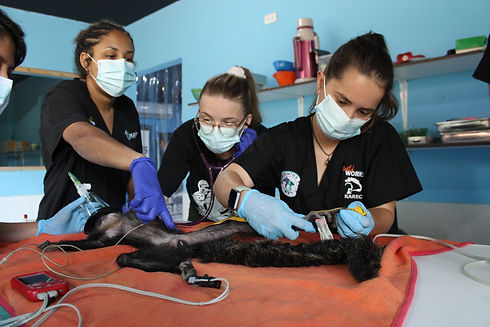Wildlife Rescue
Across the globe, countless wild animals fall victim to human-wildlife conflict, poaching, and habitat destruction. Many suffer from injuries caused by illegal snares, gunshot wounds, or territorial disputes with other animals. Others become displaced due to human encroachment, needing safe relocation to protected areas.
Our mission is to rescue, rehabilitate, and release wildlife whenever possible, ensuring that these incredible creatures have a second chance at life in their natural environment. As a team of wildlife lovers, our wildlife rescue work is close to the heart of everyone at Worldwide Vets. Wildlife work constitutes around half of our global work, and we have static vets in three locations, as well as sending out specialists, running educational courses, and outreach missions to locations each year.
Our wildlife work occurs in a number of countries.
India: In conjunction with RESQ Trust we support the rescue, treatment and rehabilitation of species like leopard, monkeys, birds, snakes and hyena
Namibia: our annual dehorning missions focus on ethically removing the horn from wild rhino to protect them from poaching
Peru: We support colleagues with veterinary care and volunteers at RAREC Center. Here we see primates like Wolley Monkeys, Capuchin monkeys and Titi Monkeys, parrots, big cats like jaguars, sloths, manatees, pink amazonian dolphins and anteaters.
South Africa: We work across the country bringing urgent care to injured wildlife and assisting with relocation and rescue of zebras, lion, elephants, antelope and giraffe.
Thailand: Thanks to our volunteers, the Southern Thailand Elephant Foundation are able to reach more elephants that are in need of care for injuries, sickness, colic and trauma.
Zimbabwe: We work in Zimbabwe to support the conservation of wild species including lion, leopard, hyena, elephants, and giraffe.




Themba the cheetah
On the 10th of July 2025, we have launched a new fundraiser to save Themba, an 11-month-old wild cheetah presented to our vets during our annual Safari Vet Internship course. She has suffered a devastating leg fracture. Without emergency surgery, she may never run again — or survive at all.
Her name is Themba, meaning Hope — and right now, she needs yours.
She was injured in the wild and so far has been transported over 1,000 km for help. The diagnosis, a fractured humerus. She needs surgery and intensive care.
Combatting Poaching
Poaching remains one of the biggest threats to wildlife in Africa. Every year, thousands of animals are caught in brutal wire snares set by illegal hunters. These indiscriminate traps maim and kill countless creatures, leaving them to suffer agonizing injuries. Our teams actively patrol high-risk areas to locate and remove these snares before they cause harm. When we find injured animals, we provide immediate veterinary care, treating wounds, preventing infections, and, when necessary, performing life-saving surgeries.
In cases where animals have been shot or injured by poachers, we step in with expert veterinary intervention. From antelopes to elephants, we work tirelessly to give these animals a fighting chance at survival. By partnering with local authorities and conservationists, we help ensure that poaching incidents are reported and addressed, contributing to broader anti-poaching efforts.

Human-Wildlife Conflict
As human populations expand, conflicts between people and wildlife increase. Animals like elephants, leopards, and lions frequently wander into villages and farms in search of food, leading to dangerous encounters. Instead of these animals being killed, we offer an alternative: relocation to safer habitats.
Using specialized equipment, tranquilization techniques, and experienced personnel, we carefully capture and transport at-risk animals to secure reserves where they can live safely without endangering human communities. This method protects both people and wildlife, fostering a future where coexistence is possible.
Strengthening Genetics
Many wildlife populations suffer from genetic isolation due to habitat fragmentation. To ensure the long-term survival of endangered species, we assist in the relocation of animals to new reserves to increase genetic diversity. By moving select individuals to new areas, we help prevent inbreeding, which can weaken populations over time.
This conservation strategy has been particularly effective for species like rhinos, cheetahs, and wild dogs, where genetic health is critical to survival. Each translocation is carefully planned with wildlife experts to ensure that the receiving environment is suitable and that the animals can thrive.


Supporting Wildlife Sanctuaries
In South America, we expand our reach by funding wildlife rescue and rehabilitation efforts in Peru and Costa Rica. These regions are home to diverse ecosystems but face significant challenges from deforestation, illegal wildlife trade, and human encroachment.
Through our partnerships with local sanctuaries, we provide essential support in multiple ways:
-
Funding veterinarians who specialize in treating injured and orphaned wildlife.
-
Donating medical supplies such as antibiotics, wound dressings, and surgical tools.
-
Providing expert guidance on veterinary interventions and rehabilitation techniques to increase survival rates.
These sanctuaries care for a wide range of species, from sloths and jaguars to parrots and monkeys. Whenever possible, the goal is to rehabilitate and release animals back into the wild, ensuring they can live free as nature intended.
